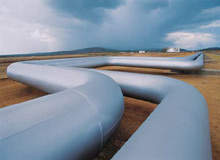
The Petrozuata project is a massive programme designed to fully exploit the oil deposits found in the Orinoco belt of Venezuela. It is part of a major effort by Venezuela to maximise its oil & gas revenues.
The sponsors of Petrozuata, which is the name of the company responsible for exploiting much of the region’s reserves, are the nationalised oil & gas company Petroleos de Venezuela S.A (PDVSA) and the American oil company Conoco.
THE OVERALL PROJECT
Some of the oil & gas production for the project is expected to come from the Zuata region, but much will be sourced from PDVSA’s operations in Zuata in the Orinoco region, some miles inland. The oil from this region is extra heavy, so some diluent is added to make it flow better along the pipe. The oil will be transported to a coastal upgrading facility, and then transported as “syncrude” in tankers to Conoco’s US refineries. Most of this syncrude will be processed at the Westlake site in Louisiana. The oil deposits are expected to last 35 years. The pipeline will also pump oil for other suppliers.
THE UPGRADER AT JOSE
The oil is transported via a 130 mile pipeline from the oil fields to the upgrading facility in Jose. The upgrader plant uses Conoco’s specialized delayed coking technology. The production capacity is 104,000 barrels/day of syncrude. This is transformed from an original 120,000 barrels/day of crude oil delivery.
Initial feasibility studies were carried out in 1991. The government and legislature of Venezuela approved the companies to prospect and exploit the region in 1993. There was then a pause whilst the finance for the project was arranged. Construction on the upgrader began in 1997. The total cost of the upgrader was in the region of $1 billion. The total construction time was three years, so the new upgrader was able to open in 2000.
Drilling for oil began in 1997. The first shipments were sent out in the second half of 1998. In contrast to the financial problems, the management of the construction proceeded on time.
COST OVERRUNS
The original cost of the project as a whole was $2.4 billion. The project was plagued by cost overruns mainly as a result of the difference between local inflation and the bolivar exchange rate. In addition, labour costs were higher than anticipated as the arrangements were renegotiated part way through the project. According to public reports, this accounted for more than 80% of the more than $500 million additional costs of the total project. This rise in costs was met by the sponsors.
LEAD CONTRACTORS
A huge number of companies have been involved in installing the project. The lead contract for the upgrader facility was awarded to the Contrina consortium, comprising Brown & Root and Parsons of the USA, French companies Technip and Projecta and DIT-Harris of Venezuela. Alstom supplied gas turbines to power the pumps which send the oil along the pipeline to the upgrader. The main control systems for the project were supplied by Honeywell. The pipeline from Zuata to Jose was laid by Wilbros. Among the lesser contracts, Accenture, which was formerly known as Andersen Consulting, provided enterprise software.
COMPANY
Conoco and Maraven are the two partners in the joint venture. They have equal shares of the equity. Maraven is a subsidiary of Petroleos de Venezuela S.A (PDVSA).

